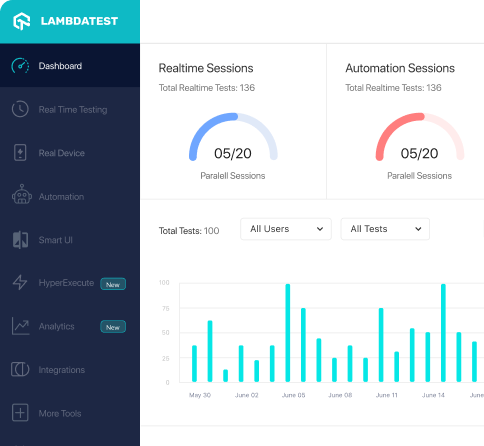How to use LocalDateTimeAssert_isBetween_with_String_parameters_Test class of org.assertj.core.api.localdatetime package
Best Assertj code snippet using org.assertj.core.api.localdatetime.LocalDateTimeAssert_isBetween_with_String_parameters_Test
...17import java.time.LocalDateTime;18import java.time.format.DateTimeParseException;19import org.assertj.core.api.LocalDateTimeAssert;20import org.junit.Test;21public class LocalDateTimeAssert_isBetween_with_String_parameters_Test22 extends org.assertj.core.api.LocalDateTimeAssertBaseTest {23 private LocalDateTime before = now.minusSeconds(1);24 private LocalDateTime after = now.plusSeconds(1);25 @Override26 protected LocalDateTimeAssert invoke_api_method() {27 return assertions.isBetween(before.toString(), after.toString());28 }29 @Override30 protected void verify_internal_effects() {31 verify(comparables).assertIsBetween(getInfo(assertions), getActual(assertions), before, after, true, true);32 }33 @Test34 public void should_throw_a_DateTimeParseException_if_start_String_parameter_cant_be_converted() {35 // GIVEN...LocalDateTimeAssert_isBetween_with_String_parameters_Test
Using AI Code Generation
1package org.assertj.core.api.localdatetime;2import org.assertj.core.api.LocalDateTimeAssert;3import org.assertj.core.api.LocalDateTimeAssertBaseTest;4import java.time.LocalDateTime;5import static org.mockito.Mockito.verify;6public class LocalDateTimeAssert_isBetween_with_String_parameters_Test extends LocalDateTimeAssertBaseTest {7 private final LocalDateTime before = LocalDateTime.now();8 private final LocalDateTime after = LocalDateTime.now().plusDays(1);9 protected LocalDateTimeAssert invoke_api_method() {10 return assertions.isBetween(before.toString(), after.toString());11 }12 protected void verify_internal_effects() {13 verify(objects).assertBetween(getInfo(assertions), getActual(assertions), before, after, true, true);14 }15}16package org.assertj.core.api.localdatetime;17import org.assertj.core.api.AbstractLocalDateTimeAssert;18import org.assertj.core.api.AbstractLocalDateTimeAssertBaseTest;19import java.time.LocalDateTime;20import static org.mockito.Mockito.verify;21public class LocalDateTimeAssert_isBetween_with_String_parameters_Test extends AbstractLocalDateTimeAssertBaseTest {22 private final LocalDateTime before = LocalDateTime.now();23 private final LocalDateTime after = LocalDateTime.now().plusDays(1);24 protected AbstractLocalDateTimeAssert invoke_api_method() {25 return assertions.isBetween(before.toString(), after.toString());26 }27 protected void verify_internal_effects() {28 verify(objects).assertBetween(getInfo(assertions), getActual(assertions), before, after, true, true);29 }30}31The tested method is LocalDateTimeAssert#isBetween(String, String, boolean, booleanLocalDateTimeAssert_isBetween_with_String_parameters_Test
Using AI Code Generation
1package org.assertj.core.api.localdatetime;2import org.assertj.core.api.*;3import org.junit.jupiter.api.Test;4import java.time.LocalDateTime;5class LocalDateTimeAssert_isBetween_with_String_parameters_Test {6 void test_isBetween_assertion() {7 Assertions.assertThat(LocalDateTime.of(2010, 1, 1, 3, 0, 5)).isBetween("2010-01-01T00:00:00", "2010-01-01T05:00:00");8 Assertions.assertThatThrownBy(() -> Assertions.assertThat(LocalDateTime.of(2010, 1, 1, 3, 0, 5)).isBetween("2010-01-01T04:00:00", "2010-01-01T05:00:00")).isInstanceOf(AssertionError.class);9 }10}11package org.assertj.core.api.localdatetime;12import org.assertj.core.api.*;13import org.junit.jupiter.api.Test;14import java.time.LocalDateTime;15class LocalDateTimeAssert_isBetween_with_String_parameters_Test {16 void test_isBetween_assertion() {17 Assertions.assertThat(LocalDateTime.of(2010, 1, 1, 3, 0, 5)).isBetween("2010-01-01T00:00:00", "2010-01-01T05:00:00");18 Assertions.assertThatThrownBy(() -> Assertions.assertThat(LocalDateTime.of(2010, 1, 1, 3, 0, 5)).isBetween("2010-01-01T04:00:00", "2010-01-01T05:00:00")).isInstanceOf(AssertionError.class);19 }20}21package org.assertj.core.api.localdatetime;22import org.assertj.core.api.*;23import org.junit.jupiter.api.Test;24import java.time.LocalDateTime;25class LocalDateTimeAssert_isBetween_with_String_parameters_Test {26 void test_isBetween_assertion() {27 Assertions.assertThat(LocalDateTime.of(2010, 1, 1, 3, 0, 5)).isBetween("2010-01-01T00:00:00", "2010-01-01T05:00:LocalDateTimeAssert_isBetween_with_String_parameters_Test
Using AI Code Generation
1package org.assertj.core.api.localdatetime;2import static org.assertj.core.api.Assertions.assertThat;3import static org.assertj.core.api.Assertions.within;4import java.time.LocalDateTime;5import org.junit.Test;6public class LocalDateTimeAssert_isBetween_with_String_parameters_Test {7 public void should_pass_if_actual_is_between_start_and_end_including_given_using_string() {8 assertThat(LocalDateTime.of(2012, 1, 1, 0, 0, 0)).isBetween("2011-12-31T23:59:59", "2012-01-01T00:00:01");9 }10 public void should_pass_if_actual_is_between_start_and_end_including_given_using_string_with_different_formats() {11 assertThat(LocalDateTime.of(2012, 1, 1, 0, 0, 0)).isBetween("2011-12-31T23:59:59", "2012-01-01");12 }13 public void should_pass_if_actual_is_equal_to_start_using_string() {14 assertThat(LocalDateTime.of(2012, 1, 1, 0, 0, 0)).isBetween("2012-01-01T00:00:00", "2012-01-01T00:00:01");15 }16 public void should_pass_if_actual_is_equal_to_end_using_string() {17 assertThat(LocalDateTime.of(2012, 1, 1, 0, 0, 0)).isBetween("2011-12-31T23:59:59", "2012-01-01T00:00:00");18 }19 public void should_pass_if_actual_is_between_start_and_end_including_given_using_string_with_offset() {20 assertThat(LocalDateTime.of(2012, 1, 1, 0, 0, 0)).isBetween("2011-12-31T23:59:59+01:00", "2012-01-01T00:00:01+01:00");21 }Blogs
Check out the latest blogs from LambdaTest on this topic:
When I started writing tests with Cypress, I was always going to use the user interface to interact and change the application’s state when running tests.
The holidays are just around the corner, and with Christmas and New Year celebrations coming up, everyone is busy preparing for the festivities! And during this busy time of year, LambdaTest also prepped something special for our beloved developers and testers – #LambdaTestYourBusiness
With the rise of Agile, teams have been trying to minimize the gap between the stakeholders and the development team.
When most firms employed a waterfall development model, it was widely joked about in the industry that Google kept its products in beta forever. Google has been a pioneer in making the case for in-production testing. Traditionally, before a build could go live, a tester was responsible for testing all scenarios, both defined and extempore, in a testing environment. However, this concept is evolving on multiple fronts today. For example, the tester is no longer testing alone. Developers, designers, build engineers, other stakeholders, and end users, both inside and outside the product team, are testing the product and providing feedback.
In my last blog, I investigated both the stateless and the stateful class of model-based testing. Both have some advantages and disadvantages. You can use them for different types of systems, depending on whether a stateful solution is required or a stateless one is enough. However, a better solution is to use an aggregate technique that is appropriate for each system. Currently, the only aggregate solution is action-state testing, introduced in the book Paradigm Shift in Software Testing. This method is implemented in Harmony.
Automation Testing Tutorials
Learn to execute automation testing from scratch with LambdaTest Learning Hub. Right from setting up the prerequisites to run your first automation test, to following best practices and diving deeper into advanced test scenarios. LambdaTest Learning Hubs compile a list of step-by-step guides to help you be proficient with different test automation frameworks i.e. Selenium, Cypress, TestNG etc.
LambdaTest Learning Hubs:
- JUnit Tutorial
- TestNG Tutorial
- Webdriver Tutorial
- WebDriverIO Tutorial
- Protractor Tutorial
- Selenium 4 Tutorial
- Jenkins Tutorial
- NUnit Tutorial
- Jest Tutorial
- Playwright Tutorial
- Cypress Tutorial
- PyTest Tutorial
YouTube
You could also refer to video tutorials over LambdaTest YouTube channel to get step by step demonstration from industry experts.
Most used methods in LocalDateTimeAssert_isBetween_with_String_parameters_Test
Try LambdaTest Now !!
Get 100 minutes of automation test minutes FREE!!



